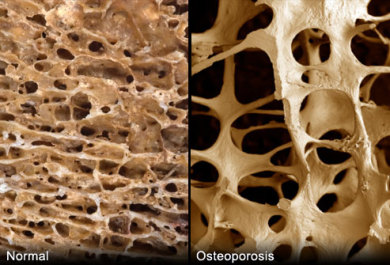Osteoporosis
Osteoporosis means "porous bones." Our bones are strongest at about age 30, then begin to lose density. More than 10 million Americans have osteoporosis, which is significant bone loss that increases the risk of fracture. About half of women 50 and older will have an osteoporosis-related fracture in their lifetime.
There are seven major risk factors that increase your chance of developing osteoporosis. These are: age, gender, ethnicity, bone structure & body weight, family history, prior history of fracture/bone breakage and use of certain medications.
Age - After maximum bone density and strength is reached (around age 30), bone mass naturally begins to decline with age.
Gender - Women over the age of 50 have the greatest risk of developing osteoporosis. Women are four times more likely to develop osteoporosis than men; thanks to their lighter, thinner bones and longer life spans.
Ethnicity - Research shows that Caucasian and Asian women are more likely to develop osteoporosis. Hip fractures are more likely to occur in Caucasian women than in African-American women; however, women of color who fracture their hips have a higher death rate.
Bone Structure & Body Weight - Petite and thin women have a greater risk of developing osteoporosis. They have less bone mass to lose than women with more body weight and larger frames. Similarly, smaller framed men are at greater risk of developing osteoporosis.
Family History - Heredity is one of the greatest risk factors for osteoporosis. If you have a parent or grandparent with osteoporosis, you may be at greater risk of developing the disease.
Prior History of Fracture/Bone Breakage - If you have broken bones in the past, you are at an increased risk of developing osteoporosis.
Certain Medications - Long term use of steroids and other medications increases your risk of developing osteoporosis.

